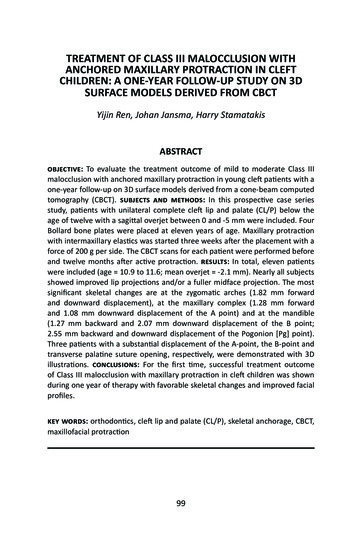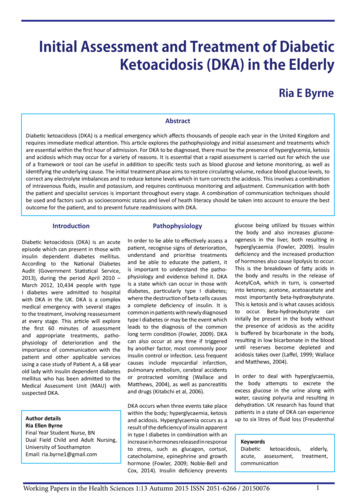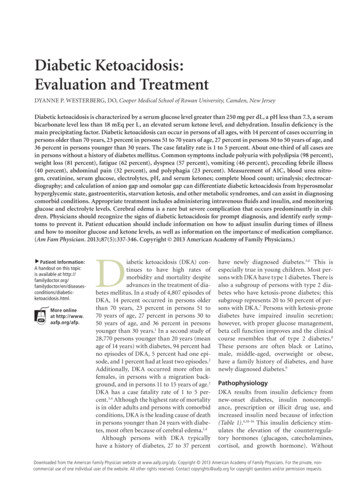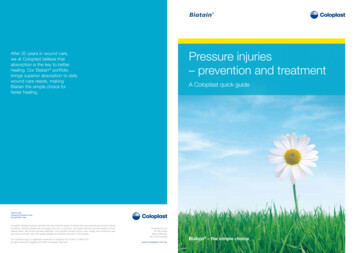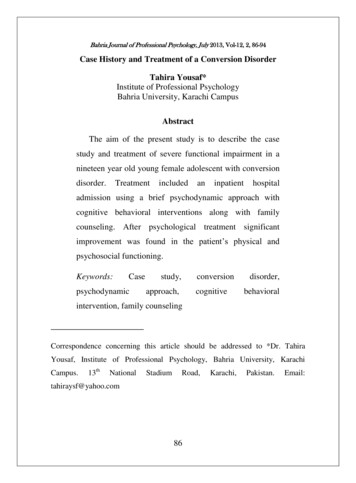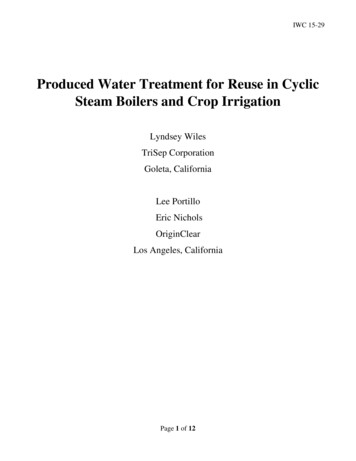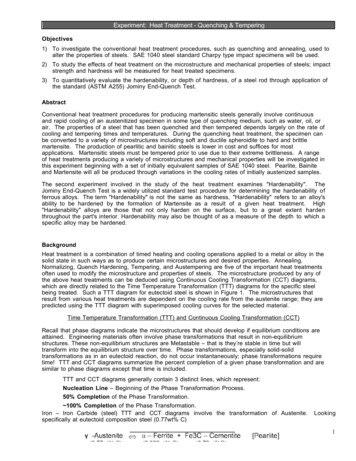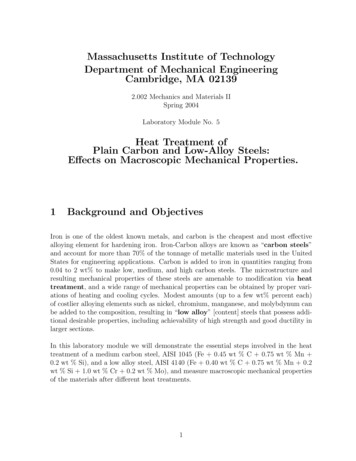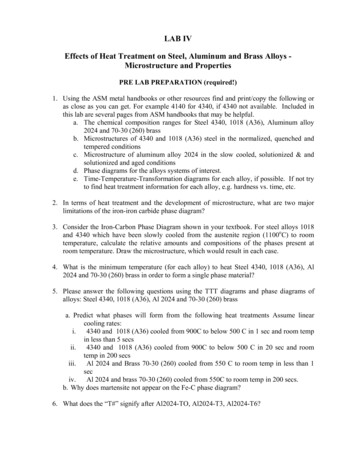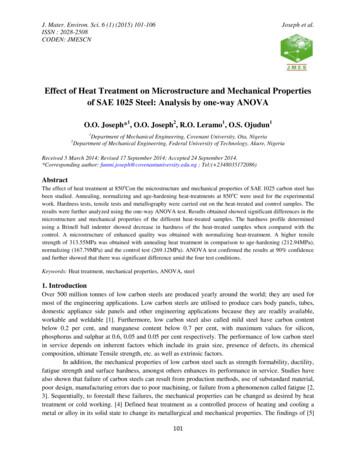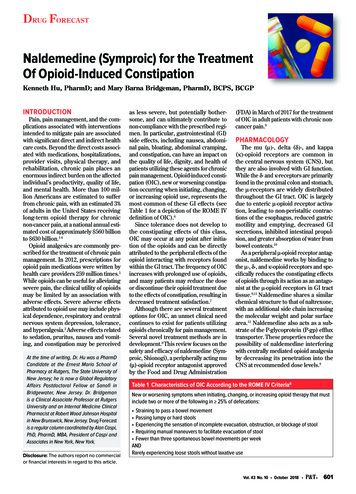
Transcription
DRUG FORECASTNaldemedine (Symproic) for the TreatmentOf Opioid-Induced ConstipationKenneth Hu, PharmD; and Mary Barna Bridgeman, PharmD, BCPS, BCGPINTRODUCTIONPain, pain management, and the complications associated with interventionsintended to mitigate pain are associatedwith significant direct and indirect healthcare costs. Beyond the direct costs associated with medications, hospitalizations,provider visits, physical therapy, andrehabilitation, chronic pain places anenormous indirect burden on the affectedindividual’s productivity, quality of life,and mental health. More than 100 million Americans are estimated to sufferfrom chronic pain, with an estimated 3%of adults in the United States receivinglong-term opioid therapy for chronicnon-cancer pain, at a national annual estimated cost of approximately 560 billionto 630 billion.1-4Opioid analgesics are commonly prescribed for the treatment of chronic painmanagement. In 2012, prescriptions foropioid pain medications were written byhealth care providers 259 million times.5While opioids can be useful for alleviatingsevere pain, the clinical utility of opioidsmay be limited by an association withadverse effects. Severe adverse effectsattributed to opioid use may include physical dependence, respiratory and centralnervous system depression, tolerance,and hyperalgesia.2 Adverse effects relatedto sedation, pruritus, nausea and vomiting, and constipation may be perceivedAt the time of writing, Dr. Hu was a PharmDCandidate at the Ernest Mario School ofPharmacy at Rutgers, The State University ofNew Jersey; he is now a Global RegulatoryAffairs Postdoctoral Fellow at Sanofi inBridgewater, New Jersey. Dr. Bridgemanis a Clinical Associate Professor at RutgersUniversity and an Internal Medicine ClinicalPharmacist at Robert Wood Johnson Hospitalin New Brunswick, New Jersey. Drug Forecastis a regular column coordinated by Alan Caspi,PhD, PharmD, MBA, President of Caspi andAssociates in New York, New York.Disclosure: The authors report no commercialor financial interests in regard to this article.as less severe, but potentially bothersome, and can ultimately contribute tonon-compliance with the prescribed regimen. In particular, gastrointestinal (GI)side effects, including nausea, abdominal pain, bloating, abdominal cramping,and constipation, can have an impact onthe quality of life, dignity, and health ofpatients utilizing these agents for chronicpain management. Opioid-induced constipation (OIC), new or worsening constipation occurring when initiating, changing,or increasing opioid use, represents themost common of these GI effects (seeTable 1 for a depiction of the ROME IVdefinition of OIC).6Since tolerance does not develop tothe constipating effects of this class,OIC may occur at any point after initiation of the opioids and can be directlyattributed to the peripheral effects of theopioid interacting with receptors foundwithin the GI tract. The frequency of OICincreases with prolonged use of opioids,and many patients may reduce the doseor discontinue their opioid treatment dueto the effects of constipation, resulting indecreased treatment satisfaction.7Although there are several treatmentoptions for OIC, an unmet clinical needcontinues to exist for patients utilizingopioids chronically for pain management.Several novel treatment methods are indevelopment.8 This review focuses on thesafety and efficacy of naldemedine (Symproic, Shionogi), a peripherally acting mu(µ)-opioid receptor antagonist approvedby the Food and Drug Administration(FDA) in March of 2017 for the treatmentof OIC in adult patients with chronic noncancer pain.9PHARMACOLOGYThe mu (µ)-, delta (δ)-, and kappa(κ)-opioid receptors are common inthe central nervous system (CNS), butthey are also involved with GI function.While the δ- and κ-receptors are primarilyfound in the proximal colon and stomach,the µ-receptors are widely distributedthroughout the GI tract. OIC is largelydue to enteric µ-opioid receptor activation, leading to non-peristaltic contractions of the esophagus, reduced gastricmotility and emptying, decreased GIsecretions, inhibited intestinal propulsion, and greater absorption of water frombowel contents.10As a peripheral µ-opioid receptor antagonist, naldemedine works by binding tothe µ-, δ-, and κ-opioid receptors and specifically reduces the constipating effectsof opioids through its action as an antagonist at the µ-opioid receptors in GI tracttissue.9,11 Naldemedine shares a similarchemical structure to that of naltrexone,with an additional side chain increasingthe molecular weight and polar surfacearea.11 Naldemedine also acts as a substrate of the P-glycoprotein (P-gp) effluxtransporter. These properties reduce thepossibility of naldemedine interferingwith centrally mediated opioid analgesiaby decreasing its penetration into theCNS at recommended dose levels.9Table 1 Characteristics of OIC According to the ROME IV Criteria6New or worsening symptoms when initiating, changing, or increasing opioid therapy that mustinclude two or more of the following in 25% of defecations: Straining to pass a bowel movement Passing lumpy or hard stools Experiencing the sensation of incomplete evacuation, obstruction, or blockage of stool Requiring manual maneuvers to facilitate evacuation of stool Fewer than three spontaneous bowel movements per weekANDRarely experiencing loose stools without laxative useVol. 43 No. 10 October 2018 P&T 601
DRUG FORECASTTable 2 Comparison of FDA-Approved Medications for the Treatment of OIC9, xegol13Lubiprostone14*Mechanismµ-, δ-, and κ-opioid receptor µ-opioid receptor antagonist µ-opioid receptor antagonistantagonistChloride channel activatorRoute of Administration OralSubcutaneous; OralOralOralAbsorption(Time to Peak)0.75 hours; 2.5 hours (withfood)Subcutaneous: 30 minutes;Oral: 1.5 hours (delayed by2 hours with high-fat meal) 2 hours; in majority ofsubjects, a secondary Cmaxoccurs 0.4 to 3 hours afterthe first CmaxM3: 1.1 hoursDistributionVz/F: 155 LVss: 1.1 L/kgVz/F: 968–2,140 LMinimal beyond GI tissuesMetabolismCYP3AConversion to methyl-6naltrexol isomers andmethylnaltrexone sulfateCYP3ACarbonyl reductaseEliminationt½: 11 hourst½: 8 hourst½: 6–11 hoursM3 t½: 0.9–1.4 hoursSide Effects Abdominal painDiarrheaNauseaGastroenteritisAbdominal painFlatulenceNauseaDizzinessAbdominal painDiarrheaNauseaFlatulenceAbdominal painDiarrheaNauseaFlatulence*Low systemic availability of lubiprostone after oral administration, with concentrations below the level of quantitation (10 pg/mL). Pharmacokinetic parameters ofM3 (its only measurable active metabolite) have been characterized.Cmax peak concentrations, Vz/F mean apparent volume of distribution during terminal phase, Vss steady-state volume of distribution, t½ half-life.PHARMACOKINETICSA summary of the pharmacokineticcharacteristics of the FDA-approvedtreatments for OIC can be found in Table2.9,11-14Absorption and DistributionWhen taken orally, naldemedine isabsorbed from the GI tract, with peakconcentrations (Cmax) occurring atapproximately 0.75 hours (Tmax) in thefasted state. There is a dose-proportional,or near dose-proportional, increase forboth Cmax and the area-under the-plasmaconcentration-time curve (AUC) and multiple daily doses of naldemedine result inminimal accumulation. A high-fat mealdecreases Cmax by approximately 35%and Tmax is extended to approximately2.5 hours when taken with food; however,the AUC does not experience a significant change as high-fat meals lower thespeed, but not the degree, of naldemedineabsorption.9,11 Naldemedine is 93% to 94%bound to human plasma proteins whentaken orally and has a mean apparentvolume of distribution of 155 L.9,11MetabolismNaldemedine undergoes hepaticmetabolism via CYP3A to nor-naldemedine. Naldemedine also undergoesmetabolism to a lesser degree through602 P&T October 2018 Vol. 43 No. 10UGT1A3 to form naldemedine 3-G. Bothmetabolites have shown antagonisticactivity for opioid receptors but to a lesserextent than naldemedine. Naldemedineis also cleaved to benzamidine and naldemedine carboxylic acid within the GItract.9,11 When [14C]-labeled naldemedinewas taken orally, nor-naldemedine wasthe primary metabolite in plasma, withapproximately 9% to 13% relative exposurecompared to naldemedine. As a minormetabolite in plasma, naldemedine 3-Ghad a relative exposure of less than 3%.9EliminationWhen [14C]-labeled naldemedine wastaken orally, 57% and 35% of the radiolabeled dose was excreted in the urineand feces, respectively. In the urine,approximately 16% to 18% of the administered dose of naldemedine was excretedunchanged. There is no estimate at thistime for the degree of change in naldemedine excreted in the feces. As the primary metabolite excreted in the urine andfeces, benzamidine represented approximately 32% and 20% of the administereddose of naldemedine, respectively.9,11Hepatic and Renal ImpairmentThe pharmacokinetic properties ofnaldemedine given once at a dose of0.2 mg in subjects with normal hepaticand renal (estimated creatinine clearance 90 mL/min) function were similar tothose in subjects with mild (estimatedglomerular filtration rate [eGFR] of 60 to89 mL/min/1.73 m2), moderate (eGFR,30 to 59 mL/min/1.73 m2), or severe(eGFR 30 mL/min/1.73 m2) renalimpairment, subjects with end-stage renaldisease requiring hemodialysis, and subjects with mild (Child-Pugh Class A) ormoderate (Child-Pugh Class B) hepaticimpairment. No adjustments are requiredwhen dosing naldemedine for patientswith mild to moderate hepatic impairment, although there have been no studies of the effect on the pharmacokineticproperties of naldemedine in subjectswith severe hepatic impairment (ChildPugh Class C) and use should be avoidedin these types of patients.9,11CLINICAL TRIALSA summary of the clinical trials leadingto the approval of naldemedine can befound in Table 3.11,15, 17-20NCT01122030Webster et al. conducted a singlecenter, randomized, double-blind, placebo-controlled, single ascending-dosephase 2a study evaluating the safety andefficacy of naldemedine at doses of 0.01mg, 0.03 mg, 0.1 mg, 0.3 mg, 1.0 mg,
DRUG FORECASTTable 3 Naldemedine Clinical Trials11,15,17-20Clinical Trial NCT0112203011, 15NumberNCT0144340311, 17NCT01965158(COMPOSE I)11, 18NCT01993940(COMPOSE II)11, 18NCT01965652(COMPOSE III) 11, 19, 20Design Phase 2a Single center, randomized, double-blind,placebo-controlled,single ascending-dosestudy Phase 2b Multicenter, randomized, double-blind,placebo-controlled,parallel-group study Phase 3 Multicenter, randomized, double-blind,placebo-controlled,parallel-group study Phase 3 Multicenter, randomized, double-blind,placebo-controlled,parallel-group study Phase 3 Multicenter, randomized, tNumber of participantswith adverse eventsMean change inweekly SBM frequencyfrom baseline to last2 weeks of treatmentPercentage of participants with a SBMresponsePercentage of participants with a SBMresponseNumber of participantswith adverse eventsResults Naldemedine: n 54 Placebo: n 18 81.5% frequency ofTEAE with naldemedine vs 50.0% frequency with placebo Abdominal pain mostfrequent Frequency generallyincreased with dose Naldemedine: n 183 Naldemedine: n 274 Naldemedine: n 277 Placebo: n 276 Placebo: n 273 Placebo: n 61 52.5% responders in 47.6% responders in Statistically signaldemedine groupnaldemedine groupnificant increase invs. 33.6% respondersvs. 34.6% respondersmean weekly SBMin placebo groupin placebo groupfrequency in 0.2-mggroup and 0.4-mggroup compared withplacebo No significant difference in frequencybetween 0.2-mg and0.4-mg doses No significant difference in frequencybetween 0.1-mg doseand placebo Naldemedine: n 621 Placebo: n 619 68.4% incidence ofTEAEs in naldemedine group vs. 72.1%incidence in placebogroup GI TEAEs more frequent in naldemedinegroup than in placebogroupConclusions Single doses generallywell tolerated Best benefit–riskprofile observed with0.3-mg dose 0.2 mg once dailyis optimal dose forfuture confirmatorytrials in OIC due toimproved safety profile over 0.4-mg dose Supports that naldemedine could be anew option for OIC inpatients with chronicnon-cancer pain Treatment with naldemedine generally welltolerated Supports that naldemedine could be anew option for OIC inpatients with chronicnon-cancer painSBM spontaneous bowel movement; TEAE treatment-emergent adverse event; OIC opioid-induced constipation; GI gastrointestinal.and 3.0-mg tablets compared to placebo.A total of 72 patients aged 18 to 65 yearswith chronic non-cancer pain and opioidinduced bowel dysfunction (no morethan five spontaneous bowel movements[SBMs] during the two weeks prior toreceiving study drug) were enrolled. Ninewere assigned to each naldemedine dosein the fasted state, and 18 were given placebo in the fasted state.11,15The primary objective was to evaluatethe safety of single doses of oral naldemedine in opioid-dependent patients.This was assessed by identifying thenumber of participants with adverseevents during the study time frame, fromthe first dose of study drug on Day 15to Day 24.15,16 Patients in the naldeme-dine groups reported more treatmentemergent adverse events (TEAEs)(81.5%) than those in the placebo group(50.0%). Increasing doses generallylead to increased frequency of specificTEAEs, with abdominal pain being themost frequently reported (16.7% of thoseon placebo and 46.3% of those on any doseof naldemedine). Greater than 10% ofpatients also experienced nausea, diarrhea, hyperhidrosis, vomiting, chills, dizziness, flatulence, and headache. SevereTEAEs were reported with naldemedine1.0 mg (drug withdrawal syndromeoccurring in one patient) and 3.0 mg (sixoccurrences of abdominal pain, diarrhea,nausea/vomiting, or chills).15Change in the number of SBMs perday was also assessed as a secondary outcome measure of efficacy. The changein the number of SBMs per day frombaseline to 24 hours post-dose was 1.83,3.76, and 4.77 in the naldemedine 0.3-mg,1.0-mg, and 3.0-mg groups, respectively, and 0.29 in the placebo group(P 0.0001 for all naldemedine groupsversus placebo). However, the change inthe naldemedine 0.01-mg, 0.03-mg, and0.1-mg mg groups was not significant.6,10These findings indicate that patients withopioid-induced bowel dysfunction generally tolerate single doses of naldemedinewell, with naldemedine 0.3 mg having thebest benefit–risk profile.15Vol. 43 No. 10 October 2018 P&T603
DRUG FORECASTNCT01443403Webster et al. conducted a subsequent four-week, multicenter, randomized, double-blind, placebo-controlled,parallel-group phase 2b study evaluatingthe safety and efficacy of naldemedine0.1-mg, 0.2-mg, and 0.4-mg tablets oncedaily in patients with OIC on long-termopioid therapy for chronic non-cancerpain. A total of 244 patients aged 18 yearsor older were randomized, evenly distributed among the three naldemedinegroups and a fourth placebo group.17The primary efficacy endpoint wasthe change from baseline to the last twoweeks of treatment in weekly SBM frequency. While the increase in frequencyof weekly SBMs was not significant withnaldemedine 0.1 mg (1.98, P 0.3504),it was significantly higher with naldemedine 0.2 mg (3.37, P 0.0014) and0.4 mg (3.64, P 0.0003), compared withplacebo recipients (1.42). Secondary endpoints included the percentage of SBMresponders (patients with 3 SBMs perweek and a 1 SBM per week increasefrom baseline over the last two weeksof treatment). While the increase in percentage of SBM responders was not significant with naldemedine 0.1 mg (52.5%,P 0.1461), the percentage of responderswas significantly higher with naldemedine 0.2 mg (71.2%, P 0.0005) and 0.4 mg(66.7%, P 0.003), compared with placebo(39.3%).11,17The study also evaluated safety measures such as incidence of adverse events,impact on analgesia, and symptoms of opioid withdrawal. The incidence of TEAEsincreased with naldemedine dose, withTEAEs generally being mild to moderate in severity and GI disorders suchas abdominal pain, diarrhea, flatulence,and nausea being the most common. Noclinically meaningful changes were seenamong other safety measures.17These findings indicate that the useof naldemedine 0.2 mg and 0.4 mg oncedaily to relieve OIC in patients withchronic non-cancer pain on long-termopioid therapy is efficacious without compromising analgesia or causing opioidwithdrawal symptoms. Because naldemedine 0.2 mg had an improved safetyprofile in the study over naldemedine0.4 mg, the 0.2-mg once daily dose wasused in future confirmatory trials inOIC.17604 P&T October 2018 Vol. 43 No. 10NCT01965158 (COMPOSE I) andNCT01993940 (COMPOSE II)Hale et al. conducted two multicenter,randomized, double-blind, placebocontrolled, parallel-group phase 3 studies evaluating the efficacy and safety ofnaldemedine for the treatment of OICin patients with chronic non-cancer painin 68 outpatient sites in seven countries(COMPOSE I) and 69 outpatient sites insix countries (COMPOSE II) in Europeand the United States. The studies evaluated 547 patients in COMPOSE I and 553patients in COMPOSE II aged 18 to 80years with OIC and chronic non-cancerpain treated with opioids for at least threemonths and with at least one month ofan average total daily dose equivalent to 30 mg of oral morphine sulfate prior toscreening. At screening, patients wererequired to discontinue all laxative therapy until the end of the study. Patientscould use rescue laxative therapy if theydid not have a SBM during screening andtreatment for a 72-hour period. Patientswere evenly distributed between naldemedine 0.2 mg or placebo once daily for12 weeks.11,18The primary endpoint was the percentage of responders with at least nine positive-response weeks (at least three SBMsper week and an increase from baseline ofat least one SBM per week) of the 12-weekstudy and three or four positive-responseweeks of the previous four weeks. Thenaldemedine group had a significantlygreater percentage of responders thanthe placebo group in both studies, with130 responders out of 273 patients (47.6%)in the naldemedine group compared to94 responders out of 272 patients (34.6%)in the placebo group in COMPOSE I(difference of 13.0% [95% CI, 4.8–21.3];P 0.002) and 145 out of 276 patients(52.5%) in the naldemedine group compared to 92 out of 274 patients (33.6%)in the placebo group in COMPOSE II(difference of 18.9% [95% CI, 10.8–27.0];P 0.0001).11,18The studies included a safety population consisting of patients who receivedat least one dose of naldemedine, andpatients were analyzed by the treatment actually received. Adverse eventsoccurred with a similar frequencybetween the naldemedine group and theplacebo group, with 132 of 271 patients(49%) in the naldemedine group compared to 123 out of 272 patients (45%) inthe placebo group in COMPOSE I and136 out of 271 patients (50%) in the naldemedine group compared to 132 out of274 patients (48%) in the placebo groupin COMPOSE II. Observable TEAEsoccurred in 59 out of 271 patients (22%)in the naldemedine group compared to45 out of 272 (17%) in the placebo groupin COMPOSE I and in 54 (20%) of 271patients in the naldemedine group compared to 31 out of 274 patients (11%)in the placebo group of COMPOSE II.GI disorders were more common withnaldemedine than with placebo, with40 patients (15%) in the naldemedinegroup compared to 18 patients (7%) inthe placebo group in COMPOSE I and 42patients (16%) in the naldemedine groupcompared to 20 patients (7%) in the placebo group in COMPOSE II.18Naldemedine use in both trials led toa much higher percentage of respondersthan use of placebo did, with comparablerates of adverse events. This supportsthe use of naldemedine as a new optionfor treating OIC in patients with chronicnon-cancer pain.18NCT01965652 (COMPOSE III)Webster et al. conducted a multicenter,randomized,
is a Clinical Associate Professor at Rutgers University and an Internal Medicine Clinical Pharmacist at Robert Wood Johnson Hospital in New Brunswick, New Jersey. Drug Forecast is a regular column coordinated by Alan Caspi, PhD, PharmD, MBA, President of Caspi and Associates in New York, New York. .
